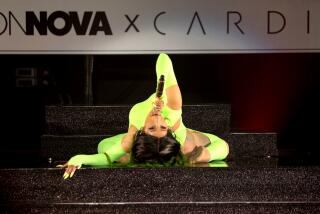Fan Maker’s Sales Go Through Ceiling : North Hollywood: Beverly Hills Fan Co.’s connection with home-improvement chains helped its profit surge 29% this year.
- Share via
Beverly Hills Fan Co. sits in a warehouse next to the railroad tracks in an industrial area of North Hollywood. It’s not Rodeo Drive, but the Beverly Hills name appears to be paying off for the company in its quest for the upscale ceiling-fan market.
The 8-year-old company designs brightly colored fans that avoid the brass-and-wood style of old. The fans have names like “Aurora,” “Ariel” and “Le Cirque,” and come in styles from Southwest to Art Deco to sleek contemporary, while another design has a simple shaft with four blades connected to a space-age-looking orb. The fans typically are connected to a ceiling-light outlet.
Beverly Hills Fan--so named because it started out in an office in Beverly Hills, according to President Shelley Greenberg--designs the fans, which are then made in Taiwan. Paint and other finishing touches are applied at the company’s North Hollywood warehouse before the fans are shipped to distributors.
Greenberg said the company kept its name even after moving to North Hollywood in 1986 because the Beverly Hills name “signified our product--we try to come up with the absolute best quality.”
The fans aren’t cheap--retail prices range from $99 to $750--but Beverly Hills Fan isn’t aiming for the discount market. It’s appealing to upper-middle-class do-it-yourselfers who want more than just a set of whirling blades to keep rooms cool.
“This was the first time a fan was designed that did not look like a ceiling fan,” said Greenberg, 40, who founded the company with his father, Hoyne, 72, who is its chairman. “It looked like a piece of art.”
Sales of the company’s fans grew 32% during the nine months that ended July 31--to $5 million--compared with the same period a year earlier, and profits climbed 29% to a record $421,000. The company’s growth has been helped by orders from large home-improvement chains such as The Home Depot, Builders Square (a division of K mart) and Handy Andy. Sales for fiscal 1990 grew 42% to $5 million from 1989 sales of $3.5 million. The company also sells fans through the Sears and J.C. Penney catalogues.
But the company had trouble keeping up with orders, so in May it made an initial public offering of stock that raised $2.3 million. Besides buying more inventory, the money helped pay off debts. According to the senior Greenberg, the company last year lost more than $1 million in sales because of low inventory.
Investors don’t appear to be holding back. The company’s stock price has risen 70% to around $3.40 a share since it was first offered at $2 in May.
Despite its growth, Beverly Hills Fan still has only about 1% of the $700-million annual U.S. fan market and its biggest competitors include Hunter Fan Co., Casablanca Fan Co. and Emerson Electric Co., which are the Big 3 in the business and make up about 25% of the U.S. fan market. The remaining 75% of the market consists of bargain fans made in Taiwan and China that have flooded the market of late, according to industry sources.
Hunter Fan Co., based in Memphis, Tenn., invented the ceiling fan in 1886 and has annual sales around $100 million, said Steve Martin, the company’s marketing services director. “Beverly Hills Fan has a negligible percent of the market share,” Martin said. “But I think they have provided a niche through the home-improvement centers that Casablanca was not able to do. They have highly specialized fans that attract a certain type of customer.”
But Casablanca, headquartered in City of Industry, still dominates the high end of the fan market even after it filed for Chapter 11 bankruptcy reorganization in March. The company, struggling under debt after it was acquired in a leveraged buyout in 1989, took a hard hit because sales at lighting showrooms slumped due to the recession. Casablanca, which had sales of about $80 million last year, emerged from bankruptcy in June after it was bought by a company set up by a subsidiary of the vast conglomerate General Electric.
Despite its small size, Beverly Hills Fan said it has an edge over Casablanca because it sells through the home-improvement chains, which are less vulnerable to economic downturns than are lighting showrooms.
Two years ago Beverly Hills Fan started selling fans to Home Depot, the big retailer with 145 stores nationwide, when Home Depot started expanding into home lighting products, including ceiling fans. It helped that Hoyne Greenberg was a friend of Home Depot’s co-founder and chief executive, Bernard Marcus, whom Greenberg had met when Greenberg ran a mirror and glass business from 1967 to 1976.
By 1990, Home Depot accounted for nearly half of Beverly Hills Fan’s sales. “There was a fit between the needs of both parties,” said Ronald Greenberg, who is Shelley Greenberg’s brother and a manufacturer’s representative for Beverly Hills Fan.
Shelley Greenberg contends that the fan business still has room for growth because a large number of people today buy fans for decorative purposes, and most fans are still less expensive than a typical wall-mounted air conditioner. Another plus is that the housing slump has not dented fan sales because most new homes don’t come equipped with fans. And remodeling, including installation of ceiling fans, has remained strong despite the recession, industry sources said.
“During a recession people cut down on expenses, but they make their homes better,” Martin said.
More to Read
Inside the business of entertainment
The Wide Shot brings you news, analysis and insights on everything from streaming wars to production — and what it all means for the future.
You may occasionally receive promotional content from the Los Angeles Times.










